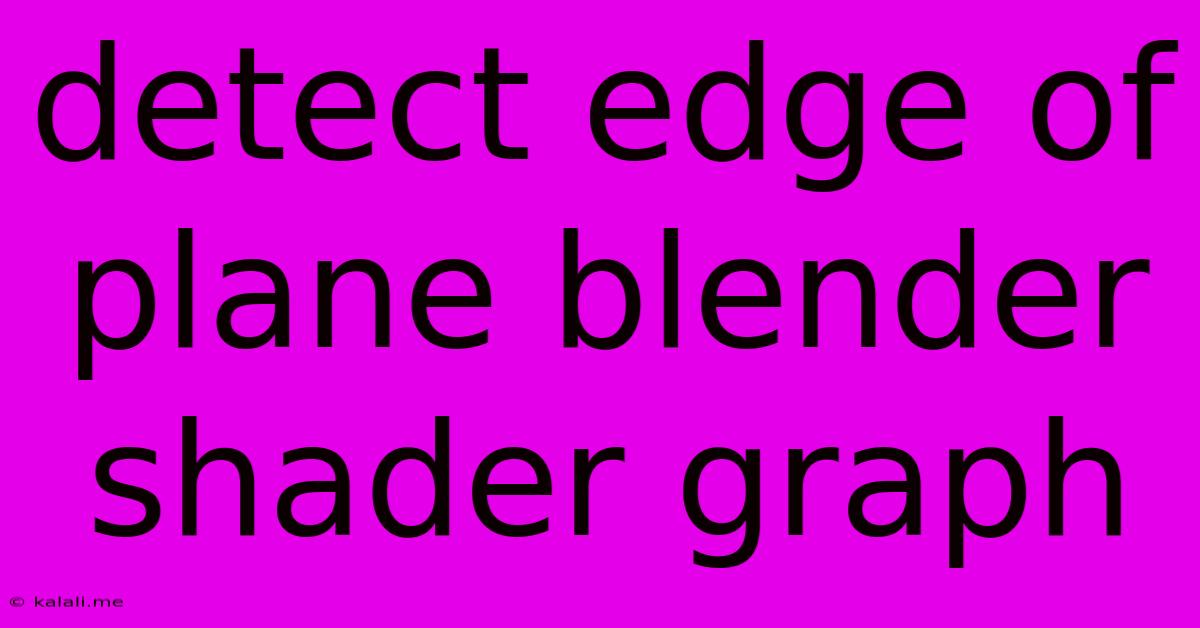Detect Edge Of Plane Blender Shader Graph
Kalali
May 23, 2025 · 3 min read

Table of Contents
Detecting Plane Edges in Blender's Shader Graph: A Comprehensive Guide
This article explores various methods for detecting the edges of a plane within Blender's Shader Graph. This is a crucial technique for many visual effects, from creating realistic wear and tear to implementing custom outlines and highlighting specific areas of your model. We'll cover several approaches, ranging from simple to more advanced, allowing you to choose the best solution for your specific needs. Understanding these methods will significantly enhance your ability to create sophisticated shaders in Blender.
Understanding the Challenge: Why Edge Detection Isn't Simple
Detecting the edge of a plane isn't as straightforward as it might seem. Unlike a solid object with clearly defined boundaries, a plane, by its nature, extends infinitely. Therefore, we need to define what constitutes an "edge" within the context of our shader. We'll primarily focus on methods that detect edges based on proximity to the plane's boundaries within a given object space.
Method 1: Using the Object Distance Node
This is perhaps the simplest method. The Object Distance node provides the distance from a point on the surface to a specified object. By using a plane as the target object and comparing the distance to a threshold value, we can effectively identify points near the edge.
- Setup: Add an Object Distance node and select your plane as the target object.
- Threshold: Connect the distance output to a Compare node. Set the threshold value based on the plane's size; a smaller value will detect a narrower edge.
- Output: Use the Compare node's output to control the color or other properties of your shader. A simple setup might use a MixRGB node to blend between two colors based on whether the point is near the edge.
Limitations: This method is sensitive to the plane's size and the chosen threshold. It might not be ideal for planes with irregular shapes or complex scenes.
Method 2: Utilizing the Geometry Node's Position and Normal
This approach leverages the Geometry node's access to the vertex position and normal vectors. By analyzing these values, we can identify points that are at or near the corners of the plane.
- Position and Normal: Use the Geometry node to get both the position and normal vectors.
- Vector Math: Employ Vector Math nodes to perform calculations on the position vector. This might involve finding the distance from the center of the plane or comparing the vector's components to the plane's dimensions.
- Thresholding and Blending: Similar to Method 1, use comparison nodes and blending nodes to determine the edge and control the shader's output.
Advantages: This method offers more control and precision, allowing for edge detection that adapts better to different plane dimensions.
Method 3: Advanced Techniques with Fractal Noise (for Stylized Effects)
For more stylized edge detection, incorporating Fractal Noise can add interesting visual effects. You can use the distance from the edge (obtained using Method 1 or 2) to modulate the noise, creating a gradual transition from the edge to the center. This technique can create realistic wear effects, procedural textures, or unique visual styles.
Advantages: Offers highly customizable, artistic edge detection effects.
Disadvantages: Requires more advanced understanding of shader graph nodes and noise functions.
Choosing the Right Method
The best method depends on your specific needs and desired outcome. For simple edge highlighting, Method 1 is a good starting point. For more complex scenes or precise control, Method 2 is recommended. If you aim for artistic, stylized effects, explore Method 3. Remember to experiment with different threshold values and node configurations to achieve the desired result.
This guide provides a solid foundation for detecting plane edges within Blender's Shader Graph. By mastering these techniques, you can unlock a wealth of creative possibilities in your shader design. Remember that practice is key – experimenting with different node combinations will help you develop your skills and find the perfect approach for your unique projects.
Latest Posts
Latest Posts
-
Mother And I Or Mother And Me
Jul 18, 2025
-
How Many Oz In One Water Bottle
Jul 18, 2025
-
How Many Dimes In A 5 Roll
Jul 18, 2025
-
How Do You Say Basil In Spanish
Jul 18, 2025
-
How Many Cookies Are In A Dozen
Jul 18, 2025
Related Post
Thank you for visiting our website which covers about Detect Edge Of Plane Blender Shader Graph . We hope the information provided has been useful to you. Feel free to contact us if you have any questions or need further assistance. See you next time and don't miss to bookmark.